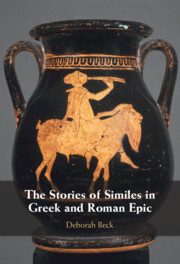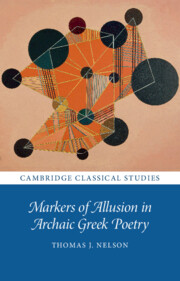62 results
Three - Stone Poets
-
- Book:
- Minoan Zoomorphic Culture
- Published online:
- 17 May 2024
- Print publication:
- 06 June 2024, pp 102-158
-
- Chapter
- Export citation
Chapter 9 - Northern Epic
- from Part II - Authorship
-
-
- Book:
- The Cambridge Companion to William Morris
- Published online:
- 03 May 2024
- Print publication:
- 23 May 2024, pp 122-134
-
- Chapter
- Export citation
Chapter 1 - The Practice of Epic and Lyric Writing in Colonial Mexico
-
-
- Book:
- A History of Mexican Poetry
- Published online:
- 21 March 2024
- Print publication:
- 21 March 2024, pp 16-35
-
- Chapter
- Export citation
Chapter 6 - Mediaeval Latin
-
-
- Book:
- The Cambridge Critical Guide to Latin Literature
- Published online:
- 04 January 2024
- Print publication:
- 18 January 2024, pp 272-333
-
- Chapter
- Export citation
Chapter 1 - Reparative Intertextualities
- from Part I - Reparative Reading
-
- Book:
- Sappho and Homer
- Published online:
- 07 December 2023
- Print publication:
- 21 December 2023, pp 19-34
-
- Chapter
- Export citation
Chapter 3 - Sacrifice
- from Part I - Developing Ideals
-
- Book:
- Imagining War and Peace in Eighteenth-Century Britain, 1690–1820
- Published online:
- 10 January 2024
- Print publication:
- 23 November 2023, pp 75-99
-
- Chapter
- Export citation
Chapter 10 - Childe Harold’s Pilgrimage iv, Don Juan, and Beppo
-
-
- Book:
- The Cambridge Companion to Byron
- Published online:
- 02 November 2023
- Print publication:
- 16 November 2023, pp 156-175
-
- Chapter
- Export citation
11 - Romantic Nationalisms
- from Part II - Revolution to Restoration (1790–1815)
-
-
- Book:
- The Cambridge History of European Romantic Literature
- Published online:
- 10 January 2024
- Print publication:
- 09 November 2023, pp 352-374
-
- Chapter
- Export citation
Chapter 3 - Past and Future in the Iohannis
-
- Book:
- War, Rebellion and Epic in Byzantine North Africa
- Published online:
- 12 October 2023
- Print publication:
- 26 October 2023, pp 86-127
-
- Chapter
- Export citation
Chapter 1 - ‘I Sing of Things That Are Not Unknown’
-
- Book:
- War, Rebellion and Epic in Byzantine North Africa
- Published online:
- 12 October 2023
- Print publication:
- 26 October 2023, pp 1-35
-
- Chapter
- Export citation
20 - The Christianity of Latin Christian Poetry
-
-
- Book:
- The Intellectual World of Late Antique Christianity
- Published online:
- 05 October 2023
- Print publication:
- 26 October 2023, pp 366-387
-
- Chapter
- Export citation
Chapter 14 - Postmodern Metafiction
- from Part II - The Politics of Genre and Form
-
-
- Book:
- The Cambridge Companion to the Twentieth-Century American Novel and Politics
- Published online:
- 07 October 2023
- Print publication:
- 12 October 2023, pp 219-232
-
- Chapter
- Export citation
5 - Tasso and the Music of Epic
-
- Book:
- Monteverdi and the Marvellous
- Published online:
- 10 October 2023
- Print publication:
- 28 September 2023, pp 164-215
-
- Chapter
- Export citation
3 - Root Formations
-
- Book:
- An Introduction to Fantasy
- Published online:
- 07 October 2023
- Print publication:
- 07 September 2023, pp 162-224
-
- Chapter
- Export citation
Haddis Alemayehu’s Vision of the Old World: Literary Realism and the Tragedy of History in the Amharic Novel Fikir iske Mekabir
-
- Journal:
- Cambridge Journal of Postcolonial Literary Inquiry / Volume 10 / Issue 3 / September 2023
- Published online by Cambridge University Press:
- 01 September 2023, pp. 353-376
-
- Article
-
- You have access
- Open access
- HTML
- Export citation
12 - Greek Sophists and Greek Poetry in the Second Sophistic (1989)
-
- Book:
- Essays on Ancient Greek Literature and Culture
- Published online:
- 10 October 2023
- Print publication:
- 27 July 2023, pp 215-269
-
- Chapter
- Export citation
13 - Poetry and Poets in Asia and Achaea (1989)
-
- Book:
- Essays on Ancient Greek Literature and Culture
- Published online:
- 10 October 2023
- Print publication:
- 27 July 2023, pp 270-282
-
- Chapter
- Export citation

The Stories of Similes in Greek and Roman Epic
-
- Published online:
- 06 July 2023
- Print publication:
- 20 July 2023

Markers of Allusion in Archaic Greek Poetry
-
- Published online:
- 11 May 2023
- Print publication:
- 25 May 2023
-
- Book
-
- You have access
- Open access
- Export citation
4 - More a Poet than a Statesman
-
- Book:
- Romanticism and the Biopolitics of Modern War Writing
- Published online:
- 25 April 2023
- Print publication:
- 23 February 2023, pp 149-191
-
- Chapter
- Export citation



